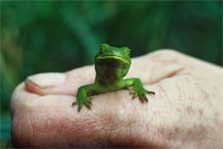What to plant
While feared by some Māori, lizards are harmless creatures that help disperse the seeds of some of our native plants, and may also pollinate their flowers.

Green gecko
Their thrifty diet of small invertebrates is easily supplemented by planting fruit-bearing shrub and vine species. Divaricating shrubs such as Coprosma propinqua, C. crassifolia, Melicytus alpinus, shrubby tororaro / Muehlenbeckia astonii and some vines like pōhuehue / Muehlenbeckia complexa are especially popular with lizards.
Tussocks deserve a mention too, as they attract a variety of small insects. Plants and advice on how to grow them can be obtained from your local native plant nursery.
Skinks
All South Island skinks (Oligosoma species) are active by day, foraging or basking in warm sunny spots. Being shy creatures of habit, their ideal piece of real estate would have plenty of undisturbed cover, piles of loosely-stacked rocks, stones, tiles or bricks for basking and a predator-free environment.
Geckos
Green geckos (Naultinus species) are active by day, and inhabit native shrubland and forested areas.
Brown geckos (Hoplodactylus species) are nocturnal (active at night) and sometimes take up residence in wood-piles, old sheds and houses. They will readily use artificial cover like roofing iron, timber, and piles of concrete blocks or tiles.
When adding cover, it is important to leave dry and dark lizard-sized gaps (no more than 5–10 mm) they can squeeze themselves into (see link to brochure).
Geckos may signal their presence by leaving ghostly-white shed skins or tell-tale dark droppings that have a white cap of uric acid at one end.